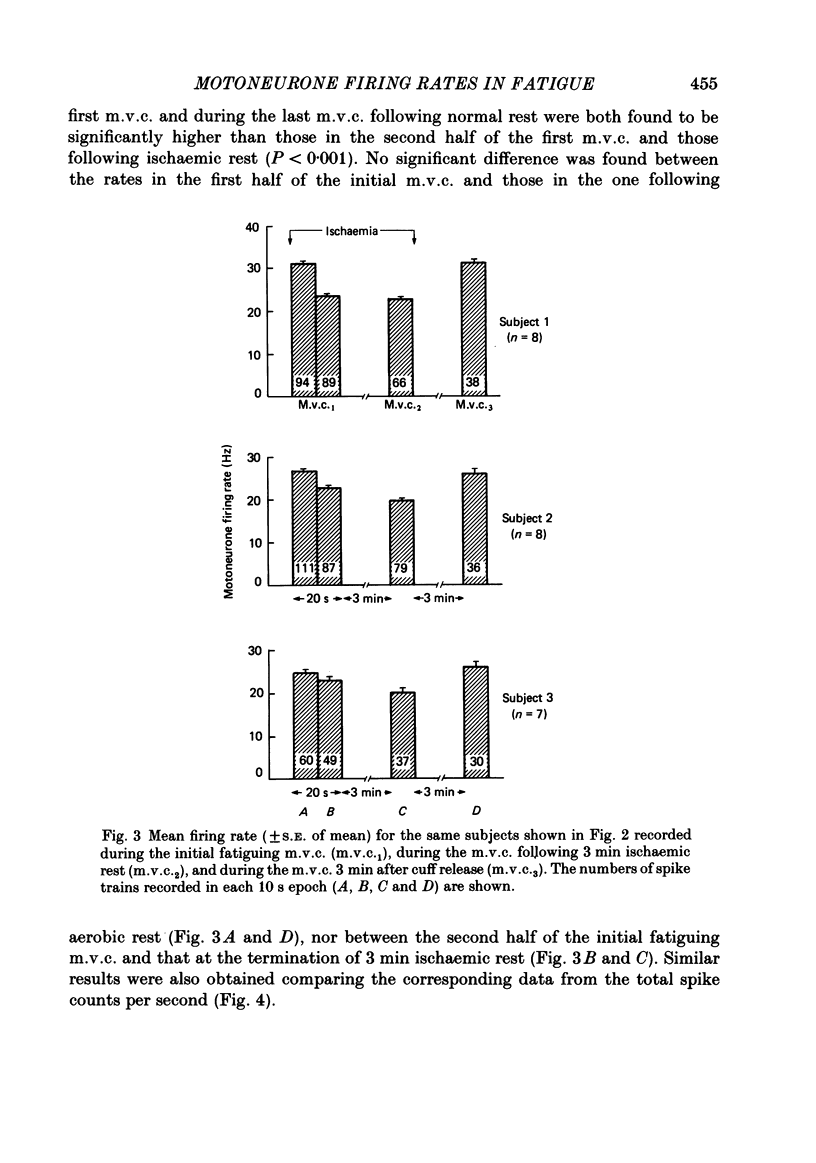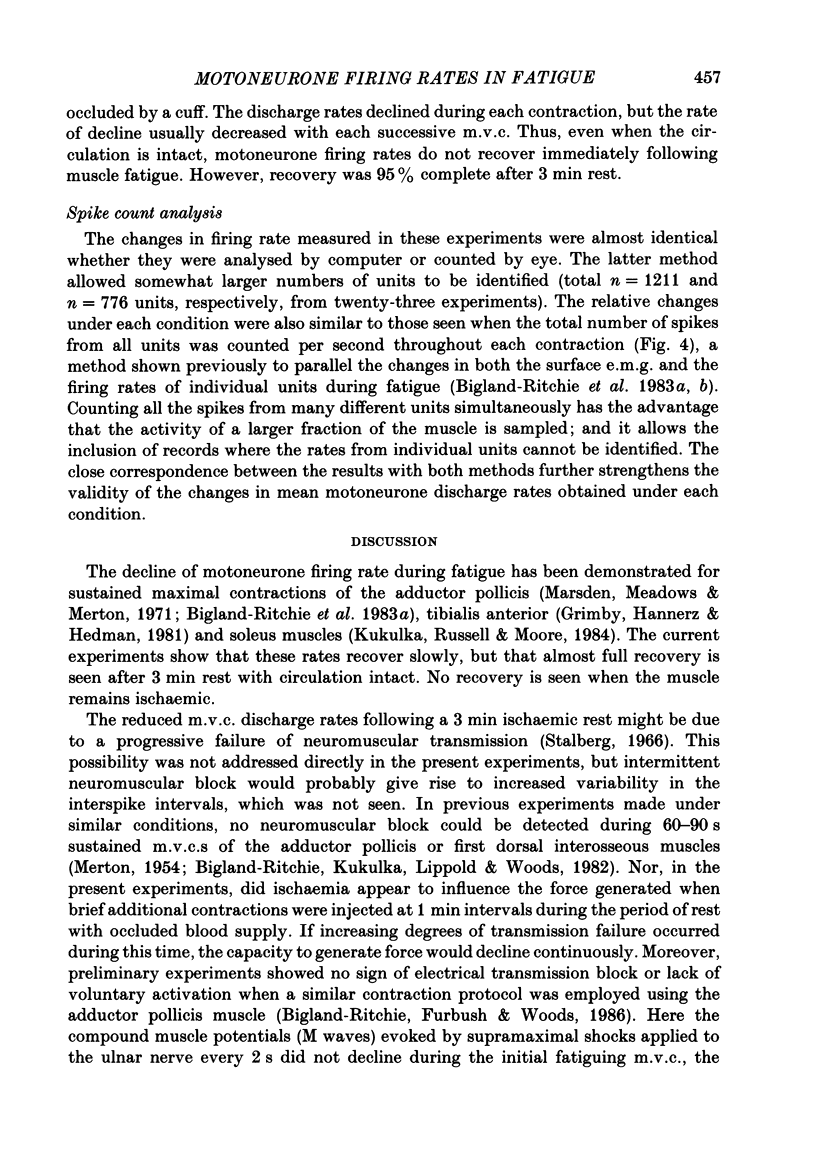Abstract
During fatigue from a sustained maximal voluntary contraction (m.v.c.) the mean motoneurone discharge rates decline. In the present experiments we found no recovery of firing rates after 3 min of rest if the fatigued muscle was kept ischaemic, but near full recovery 3 min after the blood supply was restored. Since 3 min is thus sufficient time for recovery of any central changes in excitability, the results support the hypothesis that, during fatigue, motoneurone firing rates may be regulated by a peripheral reflex originating in response to fatigue-induced changes within the muscle.
Full text
PDF








Selected References
These references are in PubMed. This may not be the complete list of references from this article.
- Bellemare F., Woods J. J., Johansson R., Bigland-Ritchie B. Motor-unit discharge rates in maximal voluntary contractions of three human muscles. J Neurophysiol. 1983 Dec;50(6):1380–1392. doi: 10.1152/jn.1983.50.6.1380. [DOI] [PubMed] [Google Scholar]
- Bigland-Ritchie B., Johansson R., Lippold O. C., Smith S., Woods J. J. Changes in motoneurone firing rates during sustained maximal voluntary contractions. J Physiol. 1983 Jul;340:335–346. doi: 10.1113/jphysiol.1983.sp014765. [DOI] [PMC free article] [PubMed] [Google Scholar]
- Bigland-Ritchie B., Johansson R., Lippold O. C., Woods J. J. Contractile speed and EMG changes during fatigue of sustained maximal voluntary contractions. J Neurophysiol. 1983 Jul;50(1):313–324. doi: 10.1152/jn.1983.50.1.313. [DOI] [PubMed] [Google Scholar]
- Bigland-Ritchie B., Kukulka C. G., Lippold O. C., Woods J. J. The absence of neuromuscular transmission failure in sustained maximal voluntary contractions. J Physiol. 1982 Sep;330:265–278. doi: 10.1113/jphysiol.1982.sp014340. [DOI] [PMC free article] [PubMed] [Google Scholar]
- Bigland-Ritchie B., Woods J. J. Changes in muscle contractile properties and neural control during human muscular fatigue. Muscle Nerve. 1984 Nov-Dec;7(9):691–699. doi: 10.1002/mus.880070902. [DOI] [PubMed] [Google Scholar]
- Cleland C. L., Rymer W. Z., Edwards F. R. Force-sensitive interneurons in the spinal cord of the cat. Science. 1982 Aug 13;217(4560):652–655. doi: 10.1126/science.7089586. [DOI] [PubMed] [Google Scholar]
- Ellaway P. H., Murphy P. R., Tripathi A. Closely coupled excitation of gamma-motoneurones by group III Muscle afferents with low mechanical threshold in the cat. J Physiol. 1982 Oct;331:481–498. doi: 10.1113/jphysiol.1982.sp014385. [DOI] [PMC free article] [PubMed] [Google Scholar]
- Grimby L., Hannerz J., Hedman B. The fatigue and voluntary discharge properties of single motor units in man. J Physiol. 1981 Jul;316:545–554. doi: 10.1113/jphysiol.1981.sp013805. [DOI] [PMC free article] [PubMed] [Google Scholar]
- Hagbarth K. E., Hägglund J. V., Nordin M., Wallin E. U. Thixotropic behaviour of human finger flexor muscles with accompanying changes in spindle and reflex responses to stretch. J Physiol. 1985 Nov;368:323–342. doi: 10.1113/jphysiol.1985.sp015860. [DOI] [PMC free article] [PubMed] [Google Scholar]
- Kernell D., Monster A. W. Motoneurone properties and motor fatigue. An intracellular study of gastrocnemius motoneurones of the cat. Exp Brain Res. 1982;46(2):197–204. doi: 10.1007/BF00237177. [DOI] [PubMed] [Google Scholar]
- Kernell D., Monster A. W. Time course and properties of late adaptation in spinal motoneurones of the cat. Exp Brain Res. 1982;46(2):191–196. doi: 10.1007/BF00237176. [DOI] [PubMed] [Google Scholar]
- Kniffki K. D., Mense S., Schmidt R. F. Responses of group IV afferent units from skeletal muscle to stretch, contraction and chemical stimulation. Exp Brain Res. 1978 Apr 14;31(4):511–522. doi: 10.1007/BF00239809. [DOI] [PubMed] [Google Scholar]
- Kumazawa T., Mizumura K. Thin-fibre receptors responding to mechanical, chemical, and thermal stimulation in the skeletal muscle of the dog. J Physiol. 1977 Dec;273(1):179–194. doi: 10.1113/jphysiol.1977.sp012088. [DOI] [PMC free article] [PubMed] [Google Scholar]
- MERTON P. A. Voluntary strength and fatigue. J Physiol. 1954 Mar 29;123(3):553–564. doi: 10.1113/jphysiol.1954.sp005070. [DOI] [PMC free article] [PubMed] [Google Scholar]
- Marsden C. D., Meadows J. C., Merton P. A. Isolated single motor units in human muscle and their rate of discharge during maximal voluntary effort. J Physiol. 1971;217 (Suppl):12P–13P. [PubMed] [Google Scholar]
- Mense S., Stahnke M. Responses in muscle afferent fibres of slow conduction velocity to contractions and ischaemia in the cat. J Physiol. 1983 Sep;342:383–397. doi: 10.1113/jphysiol.1983.sp014857. [DOI] [PMC free article] [PubMed] [Google Scholar]
- Stalberg E. Propagation velocity in human muscle fibers in situ. Acta Physiol Scand Suppl. 1966;287:1–112. [PubMed] [Google Scholar]
- Wiles C. M., Edwards R. H. The effect of temperature, ischaemia and contractile activity on the relaxation rate of human muscle. Clin Physiol. 1982 Dec;2(6):485–497. doi: 10.1111/j.1475-097x.1982.tb00055.x. [DOI] [PubMed] [Google Scholar]


